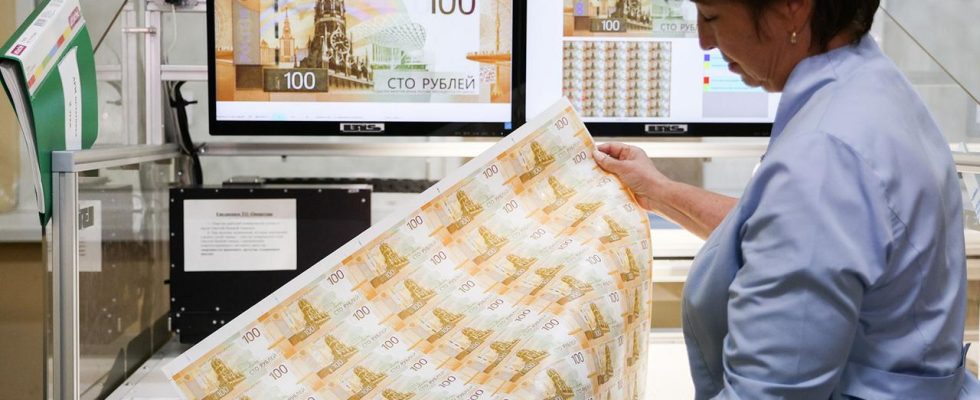faq
The Russian central bank is trying to combat the fall in the ruble by raising interest rates. But she might have little success with that. Why the ruble will continue to have a hard time in the future.
How bad is the ruble fall?
The Russian currency has been under pressure since the turn of the year. Recently, the rate of fall of the ruble had accelerated, experts speak of a real “collapse”. Within a year, the Russian currency has depreciated by 40 percent against the dollar.
Against the euro, the drop in exchange rate is even higher at 45 percent. At the start of the week, the ruble had fallen to its lowest levels since Russia’s war of aggression against Ukraine began in March 2023. At times, more than 100 rubles for a dollar and more than 110 rubles for a euro were due.
What is the reason for the sharp fall in the ruble?
A plausible explanation for this is primarily Russia’s deteriorating trade balance. Russian exports have fallen massively – behind this are falling revenues from the sale of oil and natural gas abroad. At the same time, imports, which collapsed after Russia invaded Ukraine, picked up again.
The logical consequence: the Russian trade surplus (exports minus imports) has fallen significantly, which in turn depresses the ruble exchange rate. The Russian central bank expects the trade surplus to fall by almost 70 percent in the current year compared to the previous year.
What role do Western sanctions play in this?
Russian exports have fallen mainly due to falling energy prices, the freeze on Russian gas sales to Europe and the Western boycott of Russian oil. The price cap for Russian oil of $60 a barrel also contributed – although Russia appears to have been able to partially circumvent this price cap using a loophole in the form of higher estimated transport costs. India and China in particular showed a great willingness to purchase Russian oil.
Are there other reasons for the ruble’s weakness?
Experts suspect that, in addition to the poor trade balance, increasing capital flight from Russia is also responsible. The Russian central bank only extended the capital controls – originally introduced in 2022 to stabilize the foreign exchange market – in the spring.
But the capital controls are said to have become increasingly flawed. More and more rich Russians should be able to bring their money abroad. “The incentive to withdraw capital from Russia should be huge,” emphasizes Commerzbank expert Tatha Ghose.
What is the Russian central bank doing to stop the ruble falling?
The Russian Central Bank (CBR) reacted to the fall in the value of the ruble with an extraordinary interest rate meeting, at which it drastically increased the key interest rate from 8.5 to 12.0 percent. This decision was made “in order to minimize the risks in terms of price stability,” explained the central bank and expressly did not rule out further interest rate hikes.
What does the central bank’s interest rate hike mean?
The fact is that a weak ruble obviously has the potential to fuel inflation further. In this respect, the reaction of the central bank is understandable. But it is also a fact that a key interest rate of 8.5 percent was already very high given an inflation rate of 4.3 percent. That corresponded to a positive real interest rate – i.e. nominal interest rate minus inflation – of 4.2 percent.
After yesterday’s interest rate hike, the real interest rate is now even at 7.7 percent. For comparison: In the euro zone, the real interest rate was recently minus 1.1 percent. In other words, the ruble’s problem is certainly not domestic interest rates – they were high enough even before the latest rate hike.
So why did the central bank raise interest rates in the first place?
Currency experts like Ulrich Leuchtmann from Commerzbank are convinced that the central bank was primarily reacting to political pressure. When the 100 ruble to the dollar mark was exceeded on Monday, the government had apparently reached a limit. An economic adviser to the Kremlin had publicly criticized the fall in the ruble.
However, the fact that the Russian central bank is reacting to political pressure at all is a remarkable change, since it had been a haven of economic-political reason and independence since the head of the central bank, Elwira Nabiullina, took office. That seems to be over now.
What are the future prospects for the ruble now?
The ruble benefited little from the increase in key interest rates. In the middle of the week, however, it is still below the $100 mark again. Market observers and economists are not surprised. Since the interest rate hike does not eliminate the actual causes of the decline in the rouble, they expect the Russian currency to remain weak for a longer period of time.
For example, Chris Weafer of Macro Advisory Partners expects a rate of around 95 rubles to the dollar in the coming months – roughly where the government would like to see the ruble. According to Ekaterina Zolotova, Russia analyst at the US think tank Geopolitical Futures, the government is aiming for an exchange rate of 80 to 90 rubles per US dollar.

